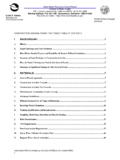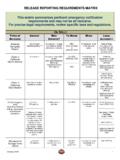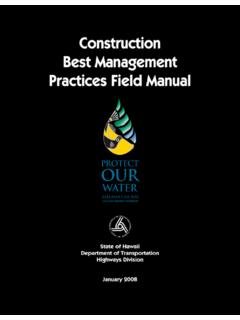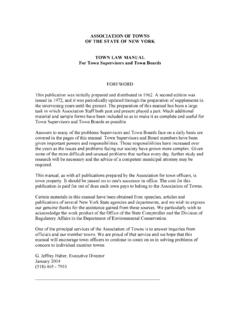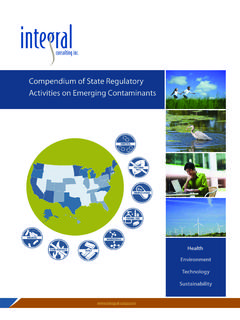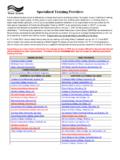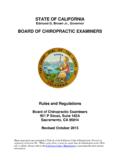Transcription of Draft Salinity Management Guidelines 090110 2 REP
1 Item No. 7; Supporting Document No. 2 PROPOSED Guidelines Salinity /NUTRIENT Management PLANNING in the SAN DIEGO REGION (9) Suggested framework and Guidelines for Salinity /nutrient Management plans required by the State of california Recycled Water Policy Prepared by: Michael R. Welch, , Consulting Engineer September 1, 2010 Southern california Salinity Coalition San Diego County Water Authority Page i Table of Contents Section 1 INTRODUCTION california Recycled Water Policy .. 1 - 1 Need for Salinity Management Coordination .. 1 - 4 Initial San Diego Region Salinity Management Workshops .. 1 - 4 Purpose of Proposed Regional Salinity Nutrient Guidelines .
2 1 - 5 Regional Board Review and Approval .. 1 - 7 Section 2 Salinity /NUTRIENT CONSTITUENTS OF CONCERN Overview .. 2 - 1 Basin Plan Groundwater Salinity Parameters of Concern .. 2 - 1 Basin Plan Groundwater Nutrient Parameters of Concern .. 2 - 7 Toxic Inorganic and Organic Parameters .. 2 - 12 Section 3 AQUIFER CHARACTERIZATION Groundwater Occurrence in the San Diego Region .. 3 - 1 Aquifer Applicability to Salinity /Nutrient 3 - 7 Proposed Tiered Salinity /Nutrient Management Approach .. 3 - 10 Classification of San Diego Region Aquifers .. 3 - 11 Potential Stakeholder Agencies .. 3 - 15 Section 4 PROPOSED APPROACH AND PRIORITIES Prior Salinity Management Planning within the Region .. 4 - 1 San Diego Region Salinity /Nutrient Management Needs .. 4 - 3 Proposed Aquifer Prioritization.
3 4 - 4 Implementation Approach .. 4 - 7 Section 5 Salinity Management TASKS Overview .. 5 - 1 Step 1 - Initial Basin Characterization .. 5 - 5 Step 2 - Identify and Quantify Salinity /Nutrient 5 - 12 Step 3 - Supplemental Monitoring .. 5 - 16 Step 4 - Assess Salinity /Nutrient Management Strategies .. 5 - 17 Step 5 - Assess Plan Effectiveness .. 5 - 23 References Appendix A - Proposed Approach and Tasks for Tier A Basins Appendix B - Proposed Approach and Tasks for Tier B Basins Appendix C - Proposed Approach and Tasks for Tier C Basins Appendix D - Regional Board Correspondence Page ii List of Figures Figure 3-1 Location of San Diego Region Groundwater Basins .. 3 - 3 Figure 3-2 Applicability of Aquifer Types to Salinity /Nutrient Management Planning.
4 3 - 8 Figure 4-1 Salinity /Nutrient Management Planning Benefits and Prioritization .. 4 - 5 List of Tables Table 2-1 Salinity Management Planning Issues and Approach Basin Plan Groundwater Objectives for Salinity Parameters .. 2 - 3 Table 2-2 Nutrient Management Planning Issues and Approach Basin Plan Groundwater Objectives for Nutrient Parameters .. 2 - 7 Table 3-1 Overview of Aquifer Types in the San Diego Region .. 3 - 2 Table 3-2 Summary of Principal Alluvial Aquifers in the San Diego Region .. 3 - 4 Table 3-3 Summary of Proposed Groundwater Basin Categories Salinity /Nutrient Management Planning in the San Diego 3 - 12 Table 3-4 Municipal Water and Wastewater Agencies within the Tier A and B Basins .. 3 - 16 Table 3-5 Municipal Water and Wastewater Agencies within the Tier C and D 3 - 17 Table 4-1 Proposed Prioritization Groups San Diego Region Alluvial Aquifers.
5 4 - 6 Table 5-1 Summary of General Approach San Diego Region Salinity /Nutrient 5 - 3 Table 5-2 Summary of Potential Salinity /Nutrient Management 5 - 20 Page iii Abbreviations and Terms AF acre-feet AFY acre-feet per year CDC Centers for Disease Control and Prevention CDPH State of california Department of Public Health CDWR State of california Department of Water Resources CFR Code of Federal Regulations CSD Community Service District EPA United states Environmental Protection Agency GIS geographic information system HSA Hydrologic Subarea HU Hydrologic Unit MCL Maximum Contaminant Level (drinking water standard) mgd million gallons per day mg/l milligrams per liter MWD Municipal Water District MWDSC Metropolitan Water District of Southern california NWRI National Water Research Institute Policy State of california Recycled Water Use Policy RCWD Rancho california Water District Region San Diego Region (9) Regional Board Regional Water Quality Control Board, San Diego Region SCSC Southern california Salinity Coalition State Board State Water Resources Control Board TDS total dissolved solids USGS Geological Survey Water Authority San Diego County Water Authority Item No.
6 7; Supporting Document No. 2 Page 1 - 1 Section 1 INTRODUCTION SUMMARY: The San Diego Regional Water Quality Control Board is encouraging local agencies, water users, and other stakeholders to develop Salinity /nutrient Management plans required under the State of california Recycled Water Policy. To assist interested agencies and stakeholders, the Southern california Salinity Coalition and San Diego County Water Authority have coordinated with the Regional Board to develop proposed Guidelines for the Salinity /nutrient Management efforts. The proposed Guidelines establish a standardized approach and framework for developing Salinity /nutrient Management plans within the San Diego Region. california Recycled Water Policy.
7 The State Water Resources Control Board (State Board) in February 2009 adopted Resolution No. 2009-011 which establishes a statewide Recycled Water Policy (hereinafter Policy). The Policy requires the State Board and the Regional Water Quality Control Boards (Regional Boards) to exercise the authority granted to them by the Legislature to the fullest extent possible to encourage the use of recycled water, consistent with state and federal water quality laws. To achieve this goal, the Policy provides direction to california 's nine Regional Boards on appropriate criteria to be used in regulating recycled water projects. (State Board, 2009a,b) The Policy recognizes that wastewater and recycled water projects may represent only a portion of the overall Salinity /nutrient loads within a watershed or groundwater basin.
8 Section of the Policy establishes that: (2) It is the intent of this policy that salts and nutrients from all sources be managed on a basin-wide or watershed-wide basis in a manner that ensures attainment of water quality objectives and protection of beneficial uses. The State Board finds that the appropriate way to address salt and nutrient issues is through the development of regional or subregional salt and nutrient Management plans rather than through imposing requirements solely on individual recycled water projects. Proposed Guidelines September 1, 2010 Section 1 Salinity /Nutrient Management Planning in the San Diego Region Introduction Page 1 - 2 Requirements (a) and (b) of the Policy state that: (a) It is the intent of this Policy for every groundwater basin/sub-basin in california to have a consistent salt/nutrient Management plan.
9 The degree of specificity within these plans and the length of these plans will be dependent on a variety of site-specific factors, including but not limited to size and complexity of a basin, source water quality, stormwater recharge, hydrogeology, and aquifer water quality. It is also the intent of the State Water Board that because stormwater is typically lower in nutrients and salts and can augment local water supplies, inclusion of a significant stormwater use and recharge component within the salt/nutrient Management plans is critical to the long-term sustainable use of water in california . Inclusion of stormwater recharge is consistent with State Water Board Resolution No. 2005-06, which establishes sustainability as a core value for State Water Board programs and also assists in implementing Resolution No.
10 2008-30, which requires sustainable water resources Management and is consistent with Objective of the State Water Board Strategic Plan Update dated September 2, 2008. (b) Salt and nutrient plans shall be tailored to address the water quality concerns in each basin/sub-basin and may include constituents other than salt and nutrients that impact water quality in the Such plans shall address and implement provisions, as appropriate, for all sources of salt and/or nutrients to groundwater basins, including recycled water irrigation projects and groundwater recharge reuse projects. It should be noted that the goal of recharging stormwater may not be consistent with the goal of attaining water quality objectives where the stormwater is of poor quality.
